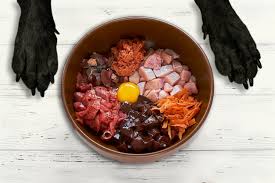A raw diet for dogs, known as BARF (raw) diet (Biologically Appropriate Food or Bones and Raw Food or Bones and Raw Food) is gaining huge popularity with pet owners who aim to feed their dogs the most natural and nutritious diet. This type of dog food is based on feeding dogs raw meat bones, food, fruits and vegetables that mimic what their ancestors would have eaten in the wild. Here’s a comprehensive look at what you should be aware of concerning raw dog food.
1. What is Raw Dog Food?
raw dog food consists of uncooked meat, organs bone, sometimes vegetables and fruits. Some believe that this kind of diet is more akin to the dog’s ancestral diet that consisted mostly of prey animals and their constituents. There are several ways to cook raw dog food, including homemade diets as well as commercially prepared raw food.
2. Benefits of Raw Dog Food
Advocates claim numerous benefits to a raw diet. They often cite improvements in coat condition, higher energy levels, better dental health and less allergies. Some owners also report that their dogs have fewer digestive issues and better weight management when they feed raw food. Raw diets are believed to be more nutrient-dense in comparison to processed kibbles, which could be a factor in these positive outcomes.
3. Risks and Considerations
Although raw dog food has its supporters, it comes with potential risks. One major concern is the threat of bacterial contamination, like Salmonella as well as E. coli, which could pose health hazards to both animals and humans. The proper handling of food and hygiene is essential when handling raw food items. Furthermore, a raw diet needs to be judiciously balanced to ensure it meets the dog’s nutritional requirements. Inadequate or unbalanced diets can lead to deficiencies or health problems over the course of time.
4. Commercial and. Homemade Raw Food
Commercial raw dog food options often come in frozen or freeze-dried form and are formulated to be nutritionally sound. They are convenient and lessen the likelihood of nutritional imbalances if they are purchased from reliable firms. Raw diets at home require careful planning and preparation to ensure all nutritional requirements are met, and to avoid potential health hazards. Consulting with a veterinarian or pet nutritionist is highly recommended for those opting to prepare raw food at home.
5. Transitioning to Raw Dog Food
The transition of a dog’s diet to a raw diet must be handled slowly to prevent digestive upset. Introduce raw food slowly while keeping track of your dog’s reaction. Regular vet check-ups are crucial to monitor your dog’s health and modify your diet as needed.
In conclusion, raw dog food can be a beneficial and natural option for dogs, but it is a subject that requires careful thought and supervision. When it comes to commercial alternatives or making your own meals maintaining the right balance of diet and the safety of food handling are essential to ensure a smooth transition and healthy outcome for your dog.



